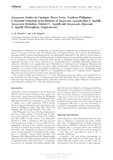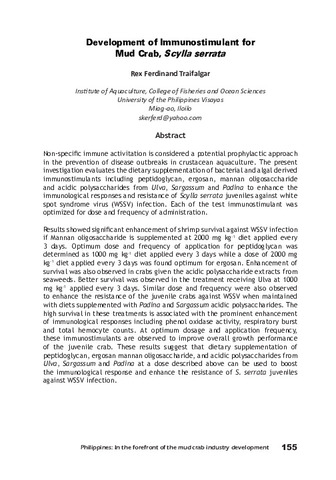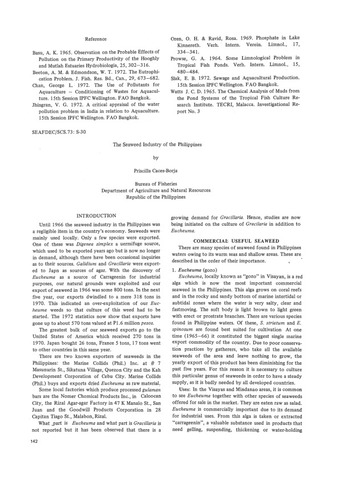Sargassum studies in Currimao, Ilocos Norte, Northern Philippines I. Seasonal variations in the biomass of Sargassum carpophyllum J. Agardh, Sargassum ilicifolium (Turner) C. Agardh and Sargassum siliquosum J. Agardh (Phaeophyta, Sargassaceae)

View/
Request this document
Date
1999Page views
171Metadata
Show full item recordCited times in Scopus
Share
Abstract
Three species of Sargassum (S. carpophyllum, S. ilicifolium and S. siliquosum were collected each month for a period of one year from the inter- and subtidal zones of Pangil, Currimao, Ilocos Norte, The Philippines. Average monthly biomass was species-specific and significantly influenced by the effect of fertility states of the seaweed, collecting zone, and collecting months. A higher biomass of reproductive plants was accounted for in all species in both zones. Among the three species, S. siliquosum had the highest reproductive and vegetative biomass in both zones, followed by S. carpophyllum and S. ilicifolium. Maximum fertility was observed in October for S. carpophyllum and in November for S. ilicifolium and S. siliquosum. Minimum and maximum reproductive biomass was recorded in May and December, respectively in all species. Biomass of vegetative or non-fertile plants was highest in September in all species except for S. carpophyllum, while minimum biomass was recorded in March for S. carpophyllum and May for S. ilicifolium and S. siliquosum. Reproductive plants had more biomass than vegetative plants.
The average monthly wet biomass (g m−2) of other Sargassum species was higher in the subtidal than in the intertidal zone. The biomass of seaweeds associated with Sargassum did not follow a definite pattern. Although water temperature, pH and salinity values were relatively constant, slight variations of temperature were positively correlated (P = 0.05) with subtidal biomass.
Suggested Citation
Hurtado, A. Q., & Ragaza, A. R. (1999). Sargassum studies in Currimao, Ilocos Norte, Northern Philippines I. Seasonal variations in the biomass of Sargassum carpophyllum J. Agardh, Sargassum ilicifolium (Turner) C. Agardh and Sargassum siliquosum J. Agardh (Phaeophyta, Sargassaceae). Botanica Marina , 42(4), 321-325. https://doi.org/10.1515/BOT.1999.036
Subject
Taxonomic term
Collections
- AQD Journal Articles [1214]
Related items
Showing items related by title, author, creator and subject.
-
Development of immunostimulant for mud crab, Scylla serrata
Traifalgar, Rex Ferdinand (Aquaculture Department, Southeast Asian Fisheries Development Center, 2017)Non-specific immune activitation is considered a potential prophylactic approach in the prevention of disease outbreaks in crustacean aquaculture. The present investigation evaluates the dietary supplementation of bacterial ... -
Approaches in Rebuilding Sea Urchin and Sea Cucumber Populations in the Philippines
Meñez, Marie Antonette J. (Training Department, Southeast Asian Fisheries Development Center, 2016)Sea urchins and sea cucumbers are among the most valuable and overexploited fishery resources. Culture and release of juvenile Tripneustes gratilla and Holothuria scabra have been undertaken to rebuild depleted populations ... -
The seaweed industry of the Philippines
Caces-Borja, Priscilla (Japan International Cooperation Agency, 1977)The paper presents the status of commercial useful seaweeds in the Philippines. Likewise, the common uses of seaweeds are also presented





